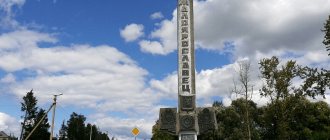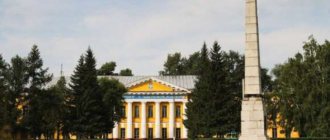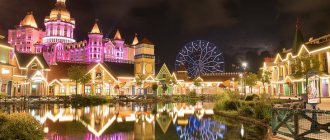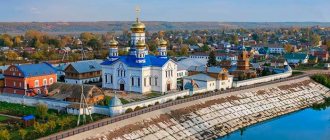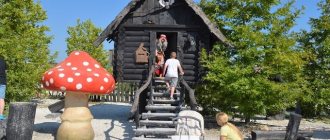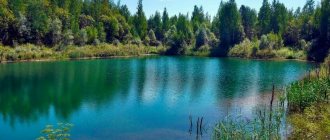What is a must-see for everyone in Sochi?
Advice! Almost any attraction in Sochi can be seen as part of a group or individual excursion. They will take you, show you everything, tell you everything and bring you back. But, if you are used to inspecting everything on your own, slowly and want to enjoy what you see without too much fuss, then renting a car will be the ideal solution for you. You can rent a car at Adler airport on the MyRentacar website.
Yew-boxwood grove
The yew-boxwood grove is a unique monument of living nature. The grove is located in the Khostinsky district of Sochi, on the slope of Mount Akhnu. The area of this nature reserve is 302 hectares. The uniqueness of the grove lies in the fact that there are no boxwood forests anywhere else in the world.
The grove became a nature reserve in 1931, and in 1936 the first hiking trail began operating on its territory. In 38, the trail was extended to the ruins of the Byzantine fortress. In 57, a new route was laid along the banks of the Khosta River.
According to scientists, the grove has existed unchanged for about 30 million years! The main attractions of the grove are the trees: yew and boxwood, which is called ironwood for its strength.
The yew grows very slowly and reaches a height of up to 30 meters at maturity. In the grove, many yew trees are over 1,500 years old, and in total yew can live up to 3,000 thousand years. The color of yew wood is red-brown, for which the plant is called mahogany. In the past, thanks to its water resistance, yew gained fame as the best material for the construction of bridge supports.
Boxwood lives up to 600 hundred years and reaches a height of 18 meters. Boxwood wood is very dense, heavy, and the tree sinks in water. At the beginning of the last century, boxwood was cut down for profit and exported to Turkey. Boxwood grows very slowly and it takes decades to restore cleared areas of forest. In addition to yew and boxwood, the grove contains 200 species of plants from more than 60 families. Beech and oak, linden, hornbeam, maple, cherry laurel and hazel - there is something to see in the grove.
In the north of the grove is the Khosta fortress - a legacy of Byzantine times, picturesque ruins of the 12th century.
The small ring of the tourist route, or boxwood, has a length of 1600 meters. At the extreme point of the path there are two observation platforms. They offer a grandiose view of the White Rocks and the bend of the Khosta River. The large pedestrian ring was closed in 1979. Its paths are fairly overgrown with bushes, but if you really want to, you can break through the relict thickets of the Great Ring.
But for those who want to keep their clothes intact and not get scratched, the grove has areas and benches for relaxation. In front of the entrance to the reserve there is a museum of flora and fauna. Although, if you are lucky, you can meet many representatives of the animal kingdom while walking along the route. Well, if not a bear, then at least a domestic cat; there are a fair number of them in the grove.
Volkonsky dolmen
None of the lovers of antiquity doubts that people lived on the territory where the city of Sochi is located many thousands of years ago. They had their own customs and traditions. Surprisingly, the surviving monuments pose questions to contemporaries that are difficult to answer unambiguously.
Nine thousand years ago, on a flat area, at a height of 4 meters, in a huge block of sandstone of irregular shape, a structure was created that resembled a “stone table” - a dolmen . This name comes from the Celtic language. Some scientists believe that these are tombs, others think that these are observatories of ancient people. Still others suggest that these are temples.
The dolmen is perfectly preserved. The inner chamber has a hemispherical shape, about 1.5 meters high. A flat floor with a recess, maybe for water drainage? The walls of the chamber have not been processed; there is no sanding of any kind. It is immediately assumed that the construction was not completed. And we, living in the twenty-first century, can only guess why the builders did not complete the interior decoration, or did not intend to. The ritual purpose of the dolmen can be evidenced by a hemispherical hole located on the back side of the dolmen.
There is a stepped approach, which is located along the end of the dolmen. Researchers of ancient monuments note that dolmens were most often located near springs or mineral springs. The outlet of hydrogen sulfide mineral water is located near the dolmen. The dolmen's façade is oriented toward the summer solstice. In order to achieve such an arrangement of the structure, the creators of the dolmen had to cut part of the boulder. This is direct evidence of the presence of quite complex instruments at that time.
Many dolmens still have plugs that close the entrance. Unfortunately, the cork of this dolmen has not been preserved. In the 19th century, the dolmen monolith was named in honor of Princess Volkonskaya. A beautiful legend is associated with these places. In ancient times, a young man from a rich family fell in love with a rootless beauty. The elder brother objected and said that he would not allow the family to be disgraced.
The young man could not defend his right to pure feeling, and said that he would rather become a stone than live without his beloved. The gods heard him, and he became a stone. The elder brother could not bear what happened and stood like a stone next to him. And the girl turned into a small river that gurgles and tells people the legend of true love. Princess Volkonskaya went down in history as a symbol of fidelity and deep love. The monolith helped her in moments of thought and anxiety.
Garden – Tree of Friendship Museum
In 1934, a scientist gardener planted a small wild lemon tree. To obtain frost-resistant varieties of citrus fruits, he grafted Japanese tangerines, Italian lemons, and American grapefruits. More than 45 species and varieties. The experimental plant gained strength and began to attract the attention of visitors with its unusual appearance.
Otto Schmidt made a graft, which became the first branch of the future tree of friendship.
In honor of strengthening friendship between Yugoslav and Soviet scientists, a vaccination was given. In 1957, Vietnamese doctors proposed calling the garden tree the Tree of Friendship . Currently, more than six hundred grafts made by representatives of almost all countries that are members of the UN live in the crown of the tree.
The authors of the so-called “green autographs” were prominent political figures. Vaccinations are done in honor of great cultural and scientific figures, historical figures. Each grafted branch has a label telling about the author. The Garden of Friendship of Nations is growing. More than 60 trees are already growing nearby. They are dedicated to the heroes of labor, space, and science. In 1981, an unusual museum was opened in the garden.
Garden - Museum The Tree of Friendship grows on the territory of the Scientific and Production Association for Industrial Floriculture and Mountain Horticulture. The plant grafting school is international. Every amateur who has completed training can receive a “Gardener Diploma.” Graduates of this school work in all countries of the world.
In 1967, the mayor of Hiroshima sent the Tree of Friendship a piece of a burnt jug and a melted cup - witnesses of the terrible tragedy. On the Tree of Friendship grow branches of memory of the tragedies and wars experienced.
The Trees of Friendship grow, bloom and bear fruit. In September 1987, the United Nations recognized the services of the city of Sochi to humanity by awarding the honorary title “Messenger of Peace.” The Tree of Friendship serves as an example for all people of good will. Peacekeeping activities are a living example for young people in different countries; in this form they are understandable without translators. Garden - Tree of Friendship Museum is open to all who care and love nature. The Banner of Peace - The Banner of Culture is in the museum. Today the Banner of Culture has become a real symbol of peace along with the Roerich Pact.
White Rocks
For those who love hiking in hilly areas, vacation organizers have developed a whole list of hiking trips to the most beautiful places in the vicinity of Sochi. Green tourism is the most environmentally friendly and safe. The main thing is to choose a route that suits your abilities and choose the appropriate equipment.
The old settlement route, which served people in the 18th and 19th centuries, has now begun to serve vacationers. The path passes through a boxwood forest, where the sun's rays cannot burn tourists, where twilight reigns all the time. The atmosphere immerses you in thought and leisurely conversation. Despite the fact that at this time the movement does not stop.
The Colchis forest envelops you in its solemnity and begins to show guests amazing plants that only here, in its kingdom, can they feel safe. The forest knows many legends about each plant, but it is in no hurry to tell everything at once. Endemics of the Western Caucasus silently greet forest guests passing by, rejoicing if no one tried to touch them. After all, they are unique in everything, which is why they live so long. The hilly terrain covered with vegetation does not make breathing difficult, the air is clear and clean.
We walked quite a bit and ended up at the observation deck of the Navalishinsky Canyon “ White Rocks ”. The foothills of the main Caucasus range appear before the audience in all their unique beauty. The sheer walls going hundreds of meters down are amazing.
The Navalishinsky Gorge is a unique monument of the Sochi Black Sea region, which is located in the valley of the Eastern Khosta River. The top marks of the rocks are at an altitude of about 250 meters above sea level. The gorge is 2 km long and more than 100 m deep. The river cuts through the gorge and reaches a depth of 3m.
The numbers are mentioned, but here all this needs to be seen, felt and remembered. The sun can't always reach the depths, so it never gets very hot. After walking a little more, the tourist finds himself on a walking path that will lead directly to the river and the White Rocks canyon. The spectacle is fascinating. A boxwood forest frames this picture and invites you to relax in the shade of the trees.
Cheap flights to Sochi by month
Night life
You shouldn’t expect Sochi’s nightclubs to have the scale and scope of their Moscow “colleagues”. And that’s not what they come here for at all. It has a relaxed resort town atmosphere. And many clubs are located near the beaches.
So, the Malibu
(Primorskaya St. 3A) attracts visitors with the scenery of a tropical island and sea views. There are bars, a restaurant with European cuisine, a dance floor and a VIP area.
Navaginskaya Street is also famous for its entertainment venues. There are karaoke clubs, bars and cafes here. And in the Mayak cabaret
Every evening they welcome lovers of karaoke, mafia and striptease.
If you want a more sophisticated environment, go to Nebar
(Riviersky Lane, 5A). There is face control here, preventing visitors in beachwear and sneakers from entering.
Sights of Sochi: what to see in Sochi on your own?
Olympic Park
The new, and, in a sense, main attraction of entertainment was the Olympic Park . It is not difficult to get to it, both from Sochi itself and from the coastal villages that belong to it. The most convenient form of transport is the train; the journey takes a little less than an hour. You can also use buses No. 57, 125, 124 C, and the Matryoshka excursion bus.
In addition, excursions to the Olympic Park are offered at every step. Tourists will not only be taken and brought back, but will also be told many interesting facts. The park is open from 8 a.m. to midnight; it is better to buy tickets through the park’s own website, where they are sold at a discount.
Seaport of Sochi
Sochi is a resort, Sochi is a seaport, Sochi is a tourist’s dream! A unique symbol of the city is the sea port, which consists of a large station complex and two passenger berths.
Vessels 220 meters long can easily moor at the port of Sochi. The beautiful design of the port area greets guests arriving in Sochi.
A magnificent view of the sea, which is constantly changing, can be observed from the gazebo erected on a hill near the main entrance of the station.
The interior of the waiting room can be perceived as a work of art. The lobby columns are decorated with majolica. The mosaic floor, shining with cleanliness, is in perfect harmony with the decoration of the walls. Two courtyards decorated with sculptures complement the ensemble of the marine terminal. Travelers arriving at the port are greeted by a magnificent ensemble. The building is decorated with a tower with a spire 36 meters high.
See the sights of Sochi on a scooter for free!
Three tiers of sculptures located on the tower solemnly welcome city guests. Four five-meter allegorical sculptures from a 20-meter height watch everything that happens. They symbolize the seasons and inform visitors that the city of Sochi welcomes guests in any weather. The mild climate, clean mountain air, the aroma of boxwood and coniferous trees, the landscape that has absorbed the beauty of the Earth's flora, open the arms of hospitality.
The sculptures of the second row from a height of 26 meters declare that all four cardinal directions are accessible to the maritime city of Sochi. The images of the twelve most intelligent creatures on Earth - dolphins - are nobly placed at a height of 35 meters. In front of the entrance to the station there is a large fountain, the diameter of the bowl is seven meters. Two small fountains are comfortably located in the courtyards.
In the center of the fountain there is a sculpture “Navigation” with a compass, a telescope and other items so necessary for sailors. Residents of Sochi know very well how important it is for those who go to sea to be waited on the shore. Sochi residents know how to meet and see off, wait and believe that everything will go well. The seaport with all its decoration shows that Sochi is a hospitable, warm and caring city.
Akhshtyrskaya cave
35 thousand years ago the Akhshtyrskaya cave . The huge number of tools found provide grounds for drawing conclusions about the knowledge and skills that people of that era possessed. Points and layers, production waste, including flakes, cores, ospreys. The emergence of the Mousterian culture dates back to approximately 300 thousand years ago; the decline of the culture occurred due to cooling.
During the heyday of their culture, Neanderthals were engaged in stone processing. Flakes broke off from the disc-shaped core, which, after upholstery, turned into various tools: scrapers, drills, knives. Bone processing was not developed. The main food consisted of meat. Hunting was the main occupation of primitive people. Bears, deer and wild boars served as objects of hunting. Neanderthals were also involved in gathering. The late Mousterian period can be studied in detail from the objects found in the cave. Stone tools were discovered in the layers of that time: pointed points, chopping tools.
Food remains are the subject of close attention of botanists, since analyzes of preserved grains and roots give an idea of the vegetation of the ancient era. The animal and plant world seem to reveal their secrets. According to archaeologists, only dark coniferous forest grew around the cave, somewhat similar to a modern forest of spruce and fir.
The inhabitants of the Old Stone Age replaced the inhabitants of the Mousterian era. And they lived in the cave neither more nor less, but more than 25 thousand years. Most importantly, the people of that era constantly improved their tools. Everyday work has borne fruit. And now you can see cutters, scrapers, chisels, knife-like plates. They knew how to handle fire, and mostly lived at the mouth of the cave, where a place for a fire was found.
Caves filled with mysteries attract people. In many countries, tourists are offered to visit caves located on their territories. They are different: there are underground lakes, with stalactites and stalagmites, but nowhere as unique as the Akhshtyrskaya Cave. For centuries, the cave was passed down by inheritance, and people owned it for centuries. We learned to live and survive in harsh times. What is not a century-old example of a hostel as a human being. Sochi is a hospitable city. He inherited from his ancestors the traditions and customs of living together. It turns out that people knew how to do this thousands of years ago. They did not destroy the cave, but passed it on to the next generation.
Art glass studio
What unusual things to see in Sochi? The glass art studio is one of the brightest and most unusual attractions of Sochi. People often wonder when looking at colored glass products, how is this possible? The whole mystery of the birth of a colored glass product can be observed by visiting the studio.
A modern glass melting furnace from the Czech Republic was installed in 2007. Specialists performed installation and commissioning work. Specialists from Sochi completed an internship with glass blowers in the Czech Republic. The exhibition of colored glass in Karlovy Vary made an indelible impression on Russian specialists. The play of colors, the shape of the products, the craftsmanship, the jewelry of the work - Sochi craftsmen wanted to know everything. Czech colleagues did not hide secrets and trained the Sochi residents to perfection. Glassblowers of the city of Sochi proudly demonstrate their skills.
Currently, the Art Glass Studio shows unique works that have absorbed the experience of ancient glassblowers and modern technologies. Each product is made by hand, it is unique, and has its own certificate. Visitors to the studio have the opportunity to observe the process of creating glass products using a glass blowing furnace and see with their own eyes how a master, using tools, manually creates a masterpiece from colored glass. The process of creating a product lasts several minutes, and the observer wants to look and enjoy together with the master a fragile flower or vase, sculpture or candlestick. The impression of what you see remains in your memory for a long time.
Touching the beautiful enriches life and makes it emotionally rich. The creators of the Art Glass Studio made sure that everyone could make an individual order in accordance with their own imagination or purchase any product they liked from those they saw at the exhibition. Artistic glass engraving, performed in the presence of the customer, will become a memorable sign of the magnificent art of artistic glass in the city of Sochi.
Witches Cave
The Ashe River flows through the Emerald Valley, but the river's flow is stormy and its character is fickle. Local Shapsug residents remember well how the river flooded the village of Kalezh. This unfortunate event occurred in August 1991. Ashe did exactly the same thing with the most interesting cultural site in the valley; the river also flooded it.
On the eroded bank of the Ashe River, not far from the mentioned village of Kalezh, there is a cave, which is a tunnel. The cave is still not well studied. It is known that this is a tunnel, the width of which is more than 2.5 m, and the height is 1.3 - 1.5 m. The true length of the cave is unknown. The cave is always wet. Along the watered bottom, daredevils make their way through a 74-meter tunnel. Further advancement is difficult due to the siphon. However, there are some researchers who go through another section beyond the first siphon. But no one has yet been able to find out what’s next.
The name “Witches Cave” scares some, intrigues others, and pushes others to extreme actions. Local Adyghe residents call this cave “Dzhyne” (Arabic - spirit, “une” - house). It turns out to be a “house of spirits”.
This same cave is called the “Cave of Salvation.” In ancient times, the inhabitants of the villages escaped from treacherous conquerors. The Adygs hid their families in a cave, then were able to find a way out into a beautiful valley. Having accommodated children and old people, the Circassians returned and took revenge on the enemy. It is believed that in ancient times there was no water in the cave. As for what happened in ancient times, and where the water came from, there is no clear answer yet. The question about the second exit from the cave needs an answer. They believe that it is quite possible that a way out exists and even name the place where it should be looked for. Not far from the village of Pseushko, 12 kilometers from the first entrance.
There are many legends about this cave. Based on a translation from Arabic, they express the idea that spirits from other planets were here. There is an earthly version. In ancient times, the cave served as a kind of “isolator” for women who were capable of intriguing against the inhabitants of the village. Having learned about the “vile” intentions, the woman was locked in the cave with a heavy stone. She could no longer get out. Why do many nations have legends about witches, why do people listen with genuine interest to stories about evil spirits and everything connected with it? The struggle between good and evil is an eternal theme, so upon hearing the name of the cave, many rush to find out more about it.
Remains of the Byzantine fortress (Bagu)
On the coastal elevated terrace on the left bank of the Godlik River, a triangular-shaped fortress was built, which was determined by the terrain. The total length of the walls is 700 meters around the perimeter. The thickness reaches 2 meters. The walls have not survived to this day; they collapsed into the sea.
The towers of the fortress have been preserved. They are located in groups of 3 in the northern and southeastern walls. Tower No. 6 occupied an area that was 4 meters deep inward and protruded 6 meters outward.
A 1 meter thick wall partitioned the tower, forming rooms. There was a narrow passage in the wall. This type of tower construction is called “twin” towers. Roman-Byzantine fortifications were often built in this style. The powerful walls reached two meters in height. The tower itself was erected above the sea at a height of 20-25 meters. The builders used sandstone, slate, and gray limestone.
During the Genoese period, an additional wall was built. The Italian masonry technique was used.
The events of antiquity are described in ancient scrolls. The ferocious geniokhs are mentioned - sea robbers, somewhat reminiscent of the Vikings. The ships were similar in shape to longships. The Geniokhs were robbers and engaged in the slave trade. Bagu Fortress was known as a trading center. The fortress was under the rule of the Byzantines for a long time, and then it was used by the Genoese. These periods date back to the 5th - 8th centuries, 14th - 15th centuries. The fortress survived antiquity and the Middle Ages in battles and sieges. On the territory of the fortress, remains of ceramic dishes, utensils, fragments of pithoi, jugs and bowls were discovered.
Caucasian State Biosphere Reserve Kh.G. Shaposhnikova
When the question arises of what to see in Sochi, one cannot fail to mention the magnificent Biosphere Museum.
The Caucasus Range has become the location of a unique reserve, which is the pride of humanity. Thousands of unique plants grow here. History has preserved the facts of the creation of the protected area.
The role of H.G. is interesting. Shaposhnikov, who served as a military forester of the Kuban Army. In 1909, he wrote a letter to the Russian Academy of Sciences. In the letter he outlined in detail the need to reserve the leased land from the Kuban Army. Man cared about the preservation of the valuable, unique world of nature. That is why the reserve is named after H.G. Shaposhnikova.
In 1924, the Caucasus State Biosphere Reserve was created on the northern and southern slopes of the Caucasus Range. In December 1999, it was included in the list of UNESCO World Natural Heritage Sites. Every year the role of the reserve increases, because the beauty of the flora and fauna created by nature is unique. The mild subtropical climate, mountain rivers and streams, lakes with crystal clear water all contribute to the growth of relict plants. The flora of the Caucasus, Japan, China, the Mediterranean, the Himalayas and Africa is presented here. The subtropical world has settled in the reserve. More than 1500 plant species. Every fifth plant is relict. Lianas coexist with evergreen conifers.
A rich rose garden, rhododendrons, boxwood and cherry laurel. Alley of tulip trees. More than 40 types of maples, ferns. The biodiversity amazes visitors to the reserve. At any time of the year, plants give people the joy of life. Yew berry, for example, living for 2.2 thousand years, is worthy of worship. Touching a tulip tree that is more than 160 years old will give you a feeling of a close connection between man and nature. The forest areas of the reserve provide the healing mountain air of Sochi, and the rivers carry clean water for the residents of Sochi.
The Caucasus State Biosphere Reserve is an open-air laboratory. A group of mountain and highland ecosystems from 260 to 3360 m above sea level reveals the secrets of the universe to everyone who feels like a part of all life on Earth. The subtropical section of the reserve is located in the Khostinsky district of Sochi. Freely located groups of trees, flower beds, and alleys are ready to greet visitors and delight with their pristine beauty.
Ideas where to go from Sochi: New Athos, Abkhazia
Returning to the Sukhumi highway, turn left, east - after 45 km you will find yourself in New Athos. At the top of Iverskaya Mountain there are partially restored ruins of a 7th-century fortress (in those days the city was called Anakopia). Inside the same mountain is the New Athos Cave, so large that there is a mini-metro in it for tourists. Dress warmly: among the stalactites and stalagmites it is cold at any time of the year.
The spiritual center of the city and all of Abkhazia - the New Athos Simon-Kananitsky Monastery - was founded at the end of the 19th century by monks from a Russian monastery on the Greek Mount Athos. In the center of the monastery stands Panteleimon Cathedral, famous for its magnificent frescoes. Two more important holy places in New Athos are the ancient temple and grotto of Simon the Zealot. And finally, take a walk to the Psyrtskha railway station: it looks like an elegant gazebo or tea house and, in addition, stands right above the picturesque lake.
What to see in Sochi with children?
Sochi Park
The most popular amusement park is Sochi Park with themed rides, a dolphinarium and playgrounds. A single ticket is purchased for the whole day, and you can freely visit all the slides, swings and pavilions.
Tickets to Sochi Park are not cheap. But when purchasing online you get a 5% discount. This ticket allows you to ride any of the flogging rides from morning to evening until you feel dizzy. And believe me, the pleasure that you will get for this money is not comparable to rides on the attractions in the Riviera.
It will definitely be interesting for everyone! For both adults and children!
Riviera Park in Sochi
In the very center of Sochi there is the Riviera amusement park. The park has more than a century of history. Until recently, on the territory of the park one could see the structure of the dacha of its founder, Moscow entrepreneur V. A. Khludov. The successor to the famous Khludov dynasty of industrialists, Vasily Alekseevich, bought a plot of land near the Sochi settlement in 1882 and developed a vigorous activity on it, befitting his ebullient character. On the coastal lands, a park, a garden of tropical plants, and vineyards were laid out.
The magazine “Russian Messenger” in the 90s of the 19th century noted Khludov’s activities in reorganizing the coastal province and promised the region considerable benefits from such projects. But failures in the steelmaking field forced Khludov to sell his lands to the Ministry of Agriculture at the beginning of the 20th century. Later, in a fragmented form, the site was resold to the city government. So, from the Khludov estate park, the wonderful Riviera park turned out. The pedestal on the main park alley was installed in 2004 in honor of the enthusiast of his business, industrialist V. A. Khludov.
Among the main attractions of the park today, it is worth mentioning the “Glade of Friendship”. The clearing was broken on April 27, 1960. According to established tradition, every honored guest of the city of Sochi plants a magnolia seedling in the Friendship Glade. To date, 45 astronauts from around the world have taken part in maintaining this glorious tradition. 250 plant species grow in the park.
Such a simple piece of park architecture as a bench requires special mention. Riviera has a large number of themed benches. Near the Fountain of Love there is a bench with the same name; newlyweds like to take pictures on it. And the “Reconciliation” bench will help preserve the union in difficult times.
At the entrance to the park there is a pond shaped like the Black Sea. And since 2007, an aquarium has been operating in the park. It is worth visiting to get acquainted with exotic species of fish and amphibians. There is a library and a sports town in the park. Shows by visiting celebrities take place on the stage of the Green Theater. And in 2010, a pump room with spring water was opened in the park, which in subtropical conditions is a very significant help for vacationers. In general, on 15 hectares of the park complex, every visitor will find something to his liking and interest.
Helpful information
- Opening hours of the Vorontsov Caves: from 10:00 to 18:00 without breaks and weekends.
- Entrance to the national park: 200 rubles - adult, children under 10 years old free.
- Tour of the cave with a local guide: 450 rubles - adults, 300 rubles - children from 7 to 12 years old.
- Temperature inside the cave: +10…+12°С. Take warm clothes (jacket or windbreaker) and sports shoes.
- The cave is equipped with railings and bridges, and is illuminated.
Walking trail to the Vorontsovskaya Cave
You need to walk 1200 meters to the Vorontsovskaya Cave (scheme at the ticket office at the entrance). The picturesque trail passes through Colchis, hornbeam and beech forests, the trees are covered with moss. Red-listed boxwood and wishing oak grow here. I didn't even notice we arrived, but some say it wasn't easy for them.
Spring of Demeter
Before the entrance to the Vorontsov Cave, a mountain spring flows from a stone head. The sculpture personifies the ancient Greek goddess Demeter, who is expecting her daughter Persephone from the kingdom of Hades. Everyone takes pictures and fills bottles with clean spring water.
You can only enter the cave with a local guide and pay for the tour. If you come on your own, you will have to wait for the group to arrive.
On the subject: Mendelikh Waterfalls Park: 3 hiking routes
What to see in Sochi in winter?
Krasnaya Polyana is a modern ski resort, which has already become one of the most beloved among our tourists.
Krasnaya Polyana is perfect for all types of tourists, be it families with children just learning to ski, or true pros looking for an unforgettable skiing or snowboarding experience.
What to see in Sochi in summer?
Summer is the main time when tourists come to vacation in Sochi. The most popular place now is the Imereti Valley, where the newest hotels and the best beaches of Sochi are located.
The Imereti Valley is the so-called “New Sochi”, which was built for the 2014 Olympics. From the Imeretian Valley it is very convenient to get to all the main attractions of Sochi. And if you have a question about what to see in Sochi, we strongly recommend staying in this place.
What to see in Sochi on excursions?
TOP 20 most popular excursions in Sochi:
- Krasnaya Polyana (visit to the observation deck of the Akh-tsu gorge, lake, waterfall (Maiden's Tears), honey tasting, cable car ride - optional visit to the Narzan springs at the Bear's Corner. Duration - 8 hours.
- Jeeping to the Khmelevskie Lakes (Akh-tsu gorge, honey tasting, “maiden’s tears” waterfall, “Khmelevskie Lakes” at an altitude of about 2000 m; road to the lakes (through mountainous terrain). Duration - 8 hours.
- Jeeping to the canyons (mountain river Psakho, 3-4 canyons, including a “dry” canyon, a functioning convent, the Church of St. George) Duration – 5 hours.
- Valley of Legends – 33 waterfalls (excursion through the city of Sochi to the Lazarevsky district, tulip tree in Golovinka (age 300-400 years), open-air museum – “Shapsutsky yard” with tea drinking, then a walk along the waterfalls, tasting honey and wines) Duration – 10 hours.
- Trout farm + ostrich farm: trout tasting, possible horse riding along the banks of the Mzymta River, excursion around the farm. Duration – 4.5 hours.
- Apiary (excursion to the apiary, an exotic story about bees and beekeeping products, then tea with honey, wine tasting, barbecue if desired) Duration - 4.5 hours.
- Rafting - 12 km takes place on a raft or catamaran for 6-8-10-12 people, then a visit to a Russian bathhouse with a swimming pool, optional trout and wine tasting. Duration – 4.5 hours.
- Rafting – 8 km along the Mzymta River. Duration – 4.5 hours.
- Rafting – 12 km + the “Mouth of the Black Dragon” gorge passes along the Mzymta River, on rafts for 8-10-12 people, stop at the gorge and a 1.5 km walk to the gorge, exotic and beautiful mountain trail, in the gorge - a waterfall , lake, recreation; then the rafting continues and at the end there is a sauna with a swimming pool, trout and wine tasting. Duration – 5 hours.
- Dolphinarium - a branch of the Utrish Dolphinarium, trip to the resort town, performance - 1 hour walk along the embankment, inspection and purchase of souvenirs - optional. Duration – 4.5 hours.
- Akhun + Riviera – a trip to Bolshoy Akhun (height 663 m above sea level, a long climb of 112 km along the road by transport, inspection of the surrounding area from the observation deck of the tower (height 693.5 m above sea level, then a walk through the Riviera park, optional - visiting attractions or cafes, museums, art galleries, souvenirs, etc. Duration - 4.5 hours.
- Overview of Sochi + Arboretum - introductory tour of Sochi, visit to the terrarium, walk through the Arboretum park - about 2 hours.
- Vorontsov Caves - excursion around the Khostinsky district, a walk through the forest to the caves (about 1 km), inspection of 5 halls of the Vorontsov Caves, stalactites, stone waterfalls, the Prometheus grotto, etc. Duration – 5 hours.
- Zmeykovskie waterfalls – a 1.5 km walk to the waterfalls on the Zmeyka River. Cascade of 5 waterfalls, view of the lakes; cafe, barbecue - optional. Duration – 4.5 hours.
- Secrets of the Georgian feast - an excursion to the Georgian farmstead on Bytkha, a story about the traditions of the feast, inspection of the farmstead, then tasting of Georgian homemade wines, optional snacks - barbecue or suckling pig on a spit, purchase of wines. Duration – 5 hours.
- Evening Sochi + sea – sightseeing tour of the city of Sochi, inspection of light and music fountains, then a walk along the sea on the ship “Dagomys”, disco, cafe - optional. Duration – 5 hours.
- Evening Sochi + wine tasting – evening city tour, light and music fountain, walk through Riviera Park, wine tasting in the tasting room in Riviera Park or at the Primorskaya Hotel (5-7 varieties of wine, canapés) Duration – 5 hours .
- Water park "Amphibius" - water attractions, a water park, a complex of children's slides, waterfalls, slides for adults, a swimming pool with a springboard, water heated to 26 degrees, shower cafes, billiards, massage, sauna if desired. Duration – 5 hours.
- Horseback riding in the mountains or along the Mzymta River for 4 hours. For each group - an instructor, a break for 30-40 minutes, optional barbecue, juices, wine. For those who are more prepared, the route is more difficult along a mountain river.
- Stalin's dacha. You will get acquainted with the architecture of the 30s - 50s of the XX century with a visit to Stalin's Dacha. Joseph Stalin loved to vacation in Sochi. At the dacha of the “father of nations” in “Green Grove”, painted, as before, in camouflage green, there are rooms where the furnishings of those years have been preserved, a billiard room, a study, a swimming pool, a fireplace room, where you can be offered a buffet with a glass of red guilt.
We are sure that in this article we were able to answer your question about what to see in Sochi.
You can book daily accommodation in Sochi on the website Sutochno.ru, and you can find package tours using the tour search widget below.
Have a nice rest!
Add extreme: Skypark AJ Hackett Sochi
You will definitely tell your grandchildren about this flight.
If you feel that you urgently need a dose of adrenaline, go to the high-altitude extreme amusement park Skypark AJ Hackett Sochi. There are no analogues to it in Russia yet. You can tickle your nerves here, for example, by walking along the world's longest pedestrian suspension bridge, or flying on a zipline over the Akhshtyr Gorge, or jumping on an elastic rope from the highest bungee platform in Russia.
Children will love traveling along the Via Ferrata iron trail: they will feel like real climbers. For romantics, Skypark has the SochiSwing attraction - the world's highest swing with free fall. You can ride alone or together. The views are exceptionally dizzying.
"Skypark" is located between the villages of Kazachiy Brod and Galitsyno, 40 km from Sochi.

